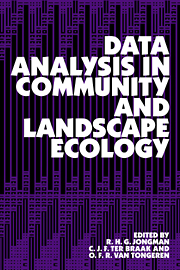Book contents
3 - Regression
Published online by Cambridge University Press: 11 October 2009
Summary
Introduction
Aim and use
Regression analysis is a statistical method that can be used to explore relations between species and environment, on the basis of observations on species and environmental variables at a series of sites. Species may be recorded in the form of abundances, or merely as being present. In contrast with ordination and cluster analysis, we cannot analyse data on all species simultaneously; in regression analysis, we must analyse data on each species separately. Each regression focuses on a particular species and on how this particular species is related to environmental variables. In the terminology of regression analysis, the species abundance or presence is the response variable and the environmental variables are explanatory variables. The term ‘response variable’ stems from the idea that the species react or respond to the environmental variables in a causal way; however, causality cannot be inferred from a regression analysis. The goal of regression analysis is more modest, namely to describe the response variable as a function of one or more explanatory variables. This function, termed the response function, usually cannot be chosen such that the function predicts responses without errors. By using regression analysis, we attempt to make the errors small and to average them to zero. The value predicted by the response function is then the expected response: the response with the error averaged out.
- Type
- Chapter
- Information
- Data Analysis in Community and Landscape Ecology , pp. 29 - 77Publisher: Cambridge University PressPrint publication year: 1995
- 47
- Cited by



